October is National Seafood Month! Sustainable seafood plays an essential role in feeding the world's growing population.
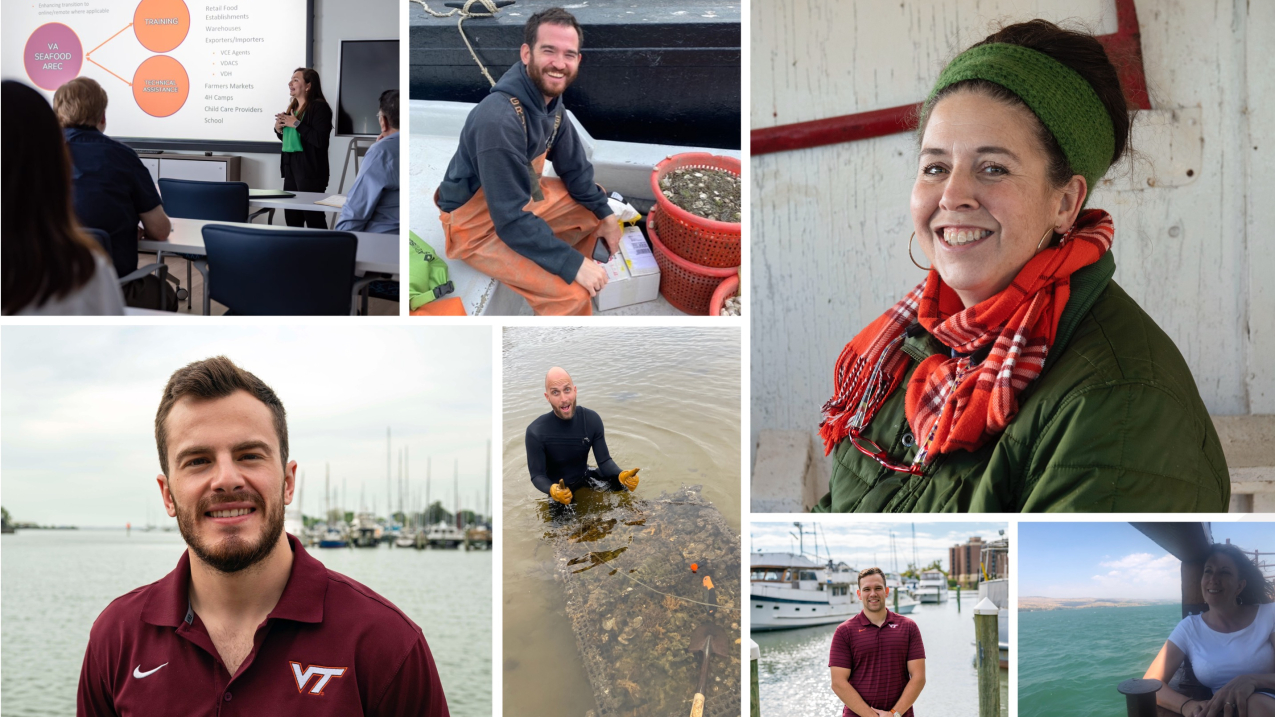
Seafood experts on the East Coast participate in everything from seafood education and outreach activities, to harvesting and researching seafood species. (Image credit: NOAA Office of Education)
Throughout New England and the Mid-Atlantic, the production of oysters, clams, mussels, Atlantic salmon, and kelp has increased substantially over the past decade. Cultured oysters are now the third most valuable seafood product harvested in these regions, behind sea scallops and the American lobster.
Learn from experts in the New England and Mid-Atlantic regions about what they're "cooking up" in the field, and in their own kitchens!
For more information, visit NOAA Fisheries Office of Aquaculture's New England and Mid-Atlantic Region fact sheet.
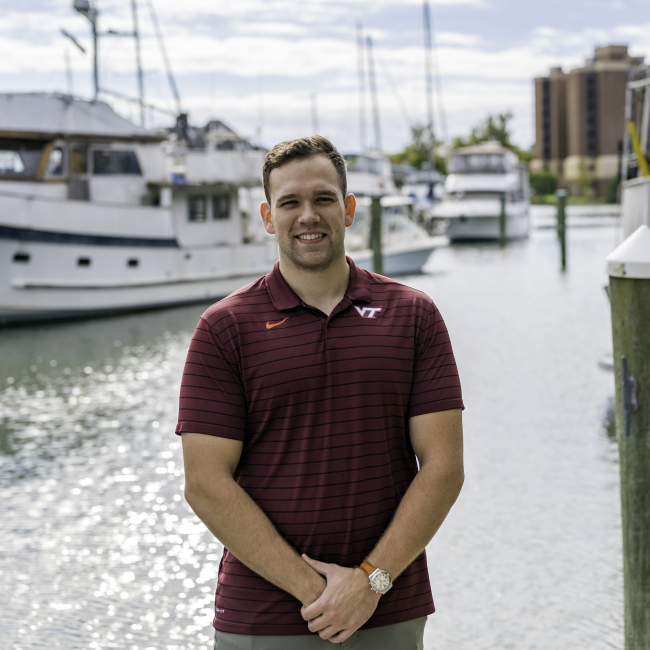
Noah Boldt
Economic Research Associate
Virginia Seafood Agricultural Research and Extension Center offsite link
Virginia Tech offsite link and Virginia Sea Grant offsite link
[We] tailor our research to the needs of the [seafood] industry, ensuring that every project has an impact on the people who rely on coastal Virginia for their livelihood.
Learn more about Noah
In what ways are you connected to seafood? Is there a specific passion that drove you to do the work that you do today?
In my role at Virginia Tech, I work on a variety of seafood economic and marketing projects which will have a direct effect on the future direction of aquaculture in the United States. My projects will help farmers develop financial statements and sustainable business practices that will enhance profitability, and ultimately allow them to streamline production and marketing processes. With our funding partners at NOAA Sea Grant, we are developing online tools across a variety of common production platforms where farmers can easily input their business data to produce financial statements useful for their farms. Additionally, we will be investigating the commercial viability of novel marine finfish for domestic aquaculture production using a multitude of economic indicators and the most cutting-edge aquaculture research from around the world. It was this opportunity to be on the forefront of aquaculture research, as well as the privilege to work directly with the men and women of the aquaculture industry, that attracted me to work at the Virginia Seafood Agricultural Research and Extension Center.
What's something unique about seafood in your region that makes it a fun sector to work or teach in?
Being located right on the water in Hampton, Virginia, our lab is surrounded by anglers, farmers, distributors, and wholesalers making it extremely easy to work directly with industry stakeholders. This allows us to tailor our research to the needs of the industry ensuring that every project has an impact on the people who rely on coastal Virginia for their livelihood.
What's something you wish everyone knew about your work or your region?
Economics is only one of the research topics that we focus at the Virginia Seafood Agricultural Research and Extension Center. Our lab is made up of food safety specialists, microbiologists, nutritionists, and cell culturists who make up some of the best researchers in their respective fields from all over the country and globe. The new facility includes state-of-the-art microbiology, food processing, cell culture, and water chemistry labs, as well as space for aquaculture and fisheries wet-lab research.
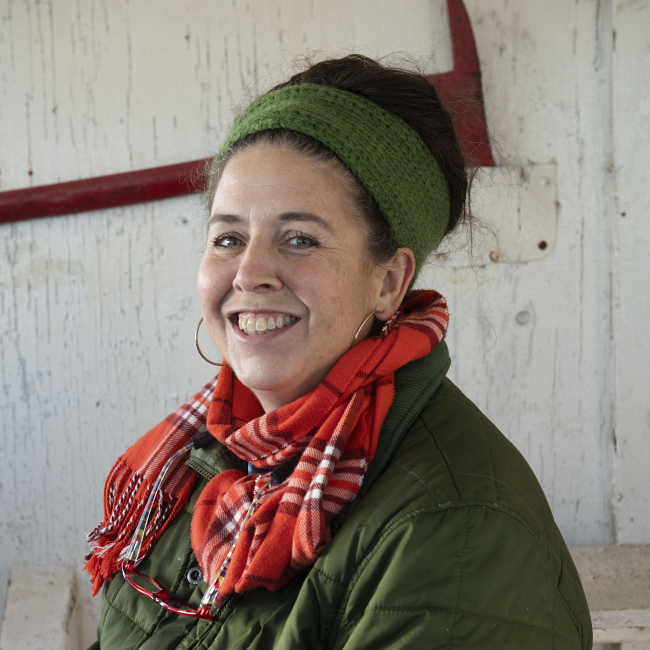
Togue Brawn
Founder and Owner of Downeast Dayboat
Maine Sea Grant offsite link grantee through Buoy Maine offsite link
Downeast Maine
We're the food world's best kept secret, and I love working with Maine's small independent operators.
Learn more about Togue
In what ways are you connected to seafood? Is there a specific passion that drove you to do the work that you do today?
Maine's commercial fishing industry has always fascinated me. I adored my lobsterman father, and my first job was in a fish/farm market. I've always worked multiple jobs at once, and the only ones I kept longer than a year involved fishing. Maine's dayboat fishermen produce the world's best shellfish; we should be the shellfish capital of the world. Some folks look at our small boats as being inefficient relative to big trip boats, but our crenulated bays produce a wide variety of shellfish, and our small boats ensure their quality is preserved from capture to delivery. We're the food world's best kept secret, and I love working with Maine's small independent operators.
What's something unique about seafood in your region that makes it a fun sector to work or teach in?
You know how wine enthusiasts talk about "terroir"? It's the sense of place that comes from specific growing regions: the sunlight, amount of rain, minerals in the soil … all of these contribute to the flavor of the wine produced from the grapes grown there. The same thing is true of shellfish: shellfish take everything they will ever be from the water they grow in. And Maine produces a wide variety of "merroirs." It's fun!
What's something you wish everyone knew about your work or your region?
Maine produces the best shellfish in the world, and we produce numerous varietals!
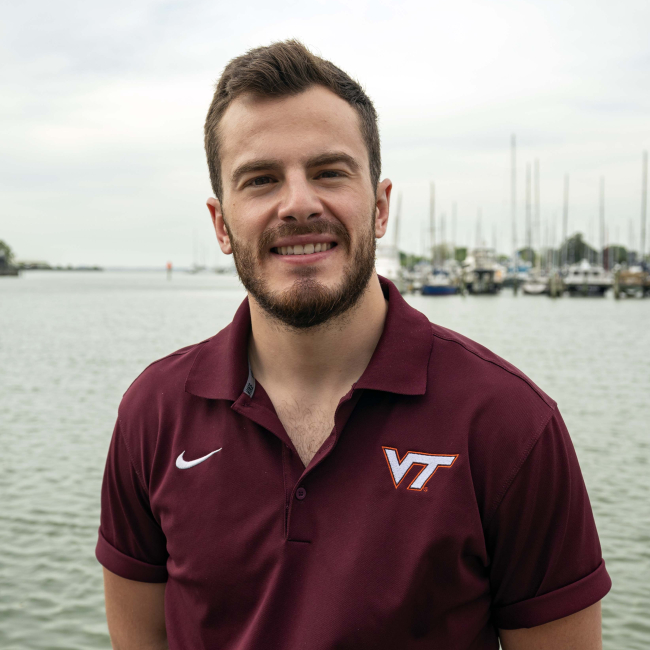
Charles Clark
Laboratory & Research Specialist
Virginia Seafood Agricultural Research and Extension Center offsite link
Given the importance [of seafood production] in the region, it is vital to build and maintain healthy relationships with producers and associated businesses.
Learn more about Charles
In what ways are you connected to seafood? Is there a specific passion that drove you to do the work that you do today?
Growing up in Southeastern Connecticut, I spent a lot of time fishing, crabbing, and digging for clams with my father and brother. While I always looked forward to these activities, I especially enjoyed cooking and eating our catch. With a professionally trained chef as a father, who could not? Overall, my time spent on the water and in the kitchen inspired me to explore aquaculture and seafood as a career path, and I have enjoyed every minute, thus far!
What's something unique about seafood in your region that makes it a fun sector to work or teach in?
Virginia is the third largest seafood producer in the United States and provides career opportunities for thousands who reside in Virginia, while also being an important food source for seafood consumers across the country. Given the importance, it is vital to build and maintain healthy relationships with producers and associated businesses. At the Virginia Seafood Agricultural Research and Extension Center, we aim to build these relationships, identify concerns and challenges industry participants face and address them through research, collaboration, and extension outreach. While very serious work, the opportunities to meet producers and visit aquaculture farms have been very educating and fun!
What's something you wish everyone knew about your work or your region?
Crassostrea virginica (the Eastern Oyster) gained its scientific name after scientists first identified the species in Virginia waters!

Zach Gordon
Regional Aquaculture Liaison
NOAA Fisheries Northeast Fisheries Science Center’s Milford Laboratory
Milford, Connecticut
I am continually amazed by the people and communities of aquaculture.
Learn more about Zach
In what ways are you connected to seafood? Is there a specific passion that drove you to do the work that you do today?
I grew up on the coast and have always been fascinated with marine life. After college, my first exposure to aquaculture was working for a hatchery where I learned the amazing role shellfish can play in sustainable food and resilient coastal environments. Since then I have worked for shellfish farms in Maine and Massachusetts, and now I work for the NOAA Fisheries Northeast Fisheries Science Center's Milford Laboratory, which is one of the world leaders in shellfish hatchery science. I am continually amazed by the people and communities of aquaculture. I aim to facilitate connections between scientists and farmers to make sure our scientific innovations are making a difference to those growing our food.
What's something unique about seafood in your region that makes it a fun sector to work or teach in?
I am fascinated by how drastically different the shellfish industry is in each state within the Northeast United States. The mix of environmental, regulatory, and infrastructure differences make each state their own unique industry, and each state has a species or aquaculture process that they feel is unique and they are proud of.
What's something you wish everyone knew about your work or your region?
Few people know that Connecticut is one of the two largest producers of shellfish on the East Coast, and one of the only places in the country that is still supported by a naturally spawning oyster population.
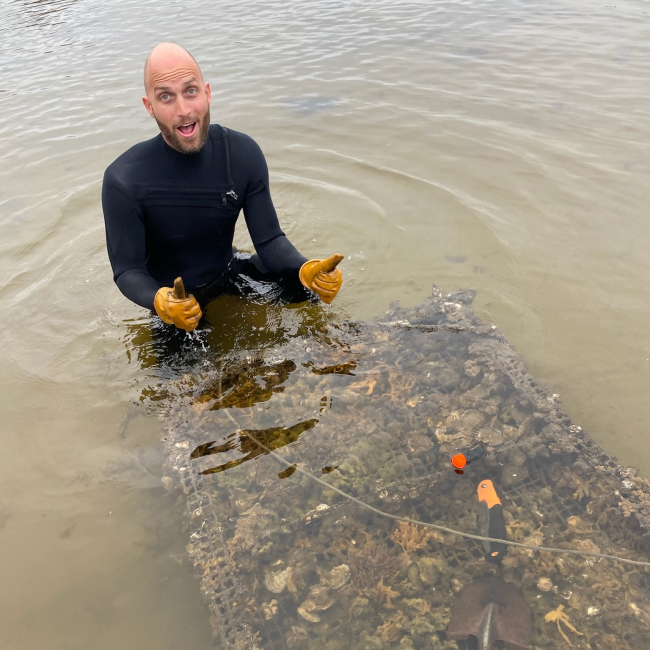
Bay McLaughlin
Co-Founder
First Landing Seafood Company
Restoration Project Partner
William & Mary and Virginia Institute of Marine Science (Sea Grant affiliates)
Virginia Beach, Virginia
Lynnhaven Oysters have a history unlike any other, with a crop referred to as "America's First Oyster." Our motto is "Eat Well. Do Good. Be Fancy."
Learn more about Bay
In what ways are you connected to seafood? Is there a specific passion that drove you to do the work that you do today?
I co-founded First Landing Seafood Company with my brothers to bring back the Lynnhaven Oyster, which was once coveted by historical figures like Queen Victoria of England, who called them "Lynnhaven Fancies." Over the last century, pollution, disease, and overharvesting drastically reduced these oyster populations. We are working with our research partners at William & Mary and Virginia institute of Marine Science to restore and revive them. We believe that everyone in the Hampton Roads community deserves a consistent, delicious, and fresh Lynnhaven Fancy. Our motto is "Eat Well. Do Good. Be Fancy."
What's something unique about seafood in your region that makes it a fun sector to work or teach in?
The Lynnhaven River in Virginia Beach is special because we are one of the most populated and customer-facing locations to produce seafood in the nation. We have a history unlike any other, with a crop referred to as "America's First Oyster" from our river. We also have a long growing season, and an incredible merroir — the unique flavor profile of our oysters due to the land, water, and climate characteristics of the region.
What's something you wish everyone knew about your work or your region?
We are restoring and reviving the home of the Lynnhaven Fancies so that everyone can enjoy America’s First Oyster™️. Named by the Queen of England, and demanded by royalty and the elite like Napoleon, you can now taste America’s first meal yourselves!
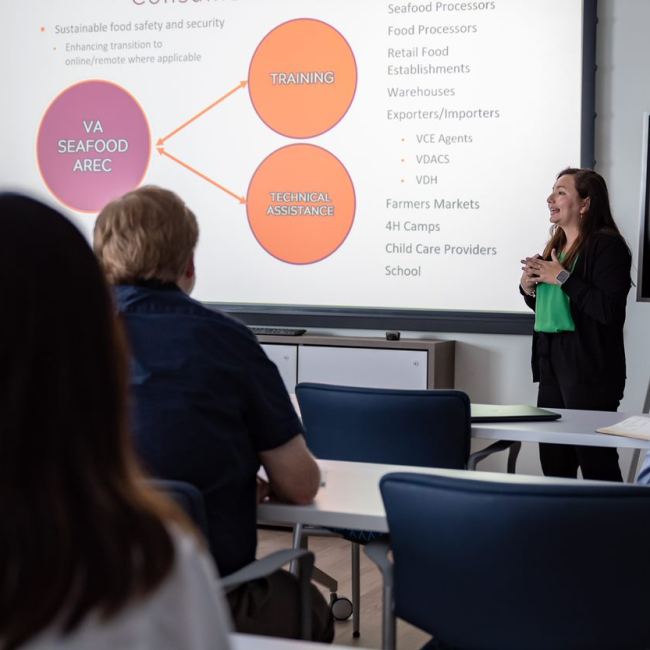
Katheryn Parraga-Estrada
Muscle Food Safety Extension Specialist
Virginia Seafood Agricultural Research and Extension Center offsite link
Virginia Tech offsite link and Virginia Sea Grant offsite link
Having many [seafood] companies around makes my work fun and interesting because I learn their different processes and how they handle their food safety programs.
Learn more about Katheryn
In what ways are you connected to seafood? Is there a specific passion that drove you to do the work that you do today?
I am connected to the seafood industry in the area of food safety. My passion for food safety drives my work because I enjoy connecting with the industry and providing guidance and knowledge about food safety for the seafood industry. As a result, I make sure the final consumer has a high-quality and safe product. Also, some companies have Spanish-speaking employees who must be trained in food safety-related areas. I am originally from Ecuador, which allows me to provide these trainings in Spanish.
What's something unique about seafood in your region that makes it a fun sector to work or teach in?
The Virginia Seafood Agricultural Research Extension Center of Virginia Tech neighbors seafood companies that process crab and other seafood products before transporting them to customers around Virginia and the east coast. Our location in Hampton is at the heart of the seafood industry, and many seafood processors in the area look to us for help with seafood safety. Having many companies around makes my work fun and interesting because I learn their different processes and how they handle their food safety programs.
What's something you wish everyone knew about your work or your region?
I am originally from Ecuador, but my life's path has led me farther and farther north with each new opportunity. When I was 12, I moved from Ecuador to Honduras. Then in 2014, I moved to Louisiana and finally, in 2021, I moved to Virginia. One day, someone pointed out my pattern of moving northward and asked me if I would keep going on… honestly, I am not sure, but that is not a plan for the moment!
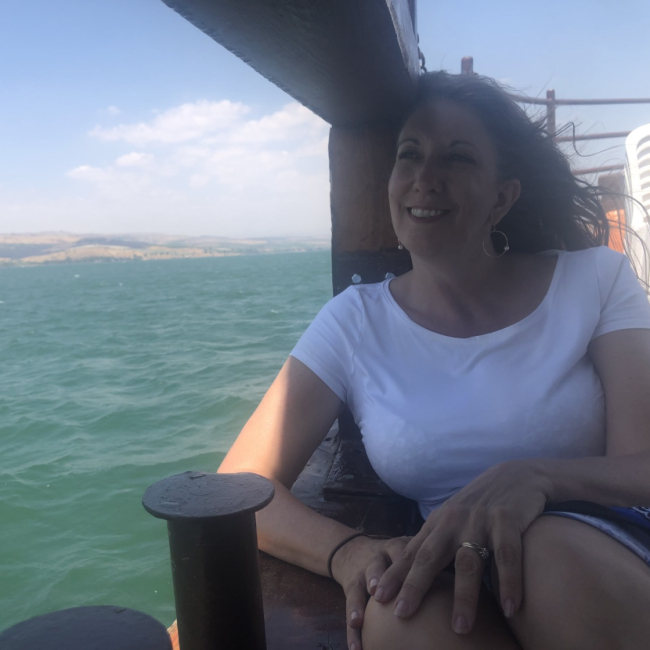
Wendy Stout
Coastal Resilience Extension Specialist
Virginia Seafood Agricultural Research and Extension Center offsite link
Virginia Tech offsite link and Virginia Sea Grant offsite link
It is amazing to come to work each day and smell the crab processing to remember why we do this type of work — we serve the people who eat the seafood products, enjoy the beaches and coastal recreation, and live in flood prone coastal zones in Virginia.
Learn more about Wendy
In what ways are you connected to seafood? Is there a specific passion that drove you to do the work that you do today?
I serve a dual role for Virginia Tech and Virginia Sea Grant working in coastal resiliency, which is vitally important for the health of oceans and other waterbodies and for healthy seafood. Good stormwater and shoreline management policies and practices, as well as blue-green-gray offsite link building practices on the coast, directly impact the cleanliness of the water and the safety of seafood. My passion for coastal resilience comes from serving as a GIS analyst during Hurricane Katrina and seeing firsthand how entire communities were destroyed. I became passionate about using GIS to improve the resiliency of Virginia's coastal communities, which is what I do in my current position.
What's something unique about seafood in your region that makes it a fun sector to work and/or teach in?
Our Virginia Seafood Agricultural Research Extension Center office, where we conduct seafood research, is located next door to the crab processing plant. It is amazing to come to work each day and smell the crab processing to remember why we do this type of work — we serve the people who eat the seafood products, enjoy the beaches and coastal recreation, and live in flood prone coastal zones in Virginia.
What's something you wish everyone knew about your work or your region?
I wish that they knew that, after Florida, Norfolk and Hampton in Virginia are the most vulnerable cities to sea level rise in the United States. This creates stress on all coastal ecosystems, ecosystems that provide recreation, protection from storms, and habitat for fish and wildlife, including commercially valuable fisheries.
Thai-inspired scallop crudo, courtesy of Togue Brawn
|
|
Directions
Remove the sweetmeat from each scallop and discard or save for making stock (you can keep them in the freezer until you accumulate enough to make a nice stock).
Slice into 2-3 thin discs, depending on size — it's easier to slice them cleanly if you place them in the freezer for 30 minutes to firm them up.
Arrange the discs on a plate and spread each piece with a dab of chili paste, then squeeze with fresh lime juice.
Top with torn cilantro leaves and a sprinkle of crispy fried shallots.
The combination of spicy sweet chili paste, tangy lime juice, creamy scallop and crispy fried shallots is addictive!
Please note if you wish to use your scallop shell as the plate, you'll need to wash it thoroughly, and don't re-use it as the shell itself is porous.
Discover more recipes from Downeast Dayboat can be found at: https://downeastdayboat.com/blogs/recipes offsite link
Scallop ceviche, courtesy of Charles Clark
|
|
Directions
Combine diced tomatillos, diced onion, minced jalapeño, citrus juices, salt and pepper in a large ceramic or glass bowl (metal bowls can react with acids and give off-flavor).
Add scallop medallions and mix in.
Allow to marinate for at least 3 hours.
Serve with avocado, plantain chips, and cilantro garnish.
Makes 4 servings!
Strawberry mignonette for Lynnhaven Fancies, courtesy of Bay McLaughlin
|
|
Directions
Add all ingredients into a nonreactive bowl and mix well.
Let rest for 5 to 10 minutes to allow the flavors to come together.
Serve about 1 teaspoon atop a freshly shucked Lynnhaven oyster, and enjoy!
Southern she-crab soup, courtesy of Wendy Stout
|
|
Directions
Melt butter in a large saucepan over medium heat.
Stir in about flour until it makes a smooth paste; stir for about 2-3 minutes.
Mix in your onion, celery, and garlic; season with salt and pepper.
Continue to cook and stir for about 4 more minutes.
Gradually whisk in half-and-half, heavy cream, and chicken broth slowly so that it doesn’t get lumps; bring to a simmer.
Pour in sherry.
Season with a little fresh chopped dill, Worcestershire sauce, and hot sauce.
Cover and simmer until soup has reduced by 1/3, which should be about 30 minutes.
Add crabmeat and simmer for 10 more minutes.
Serve and top each serving with a splash of sherry and sprinkling of chives.



